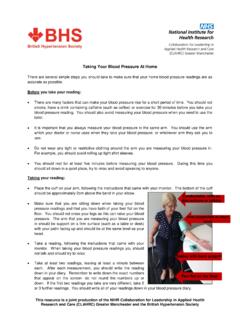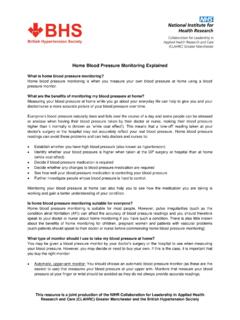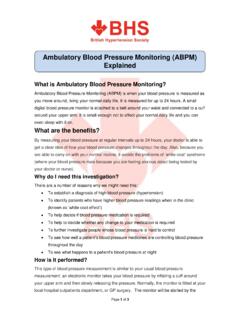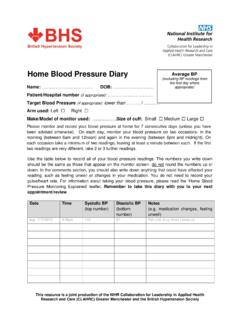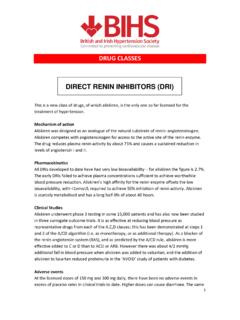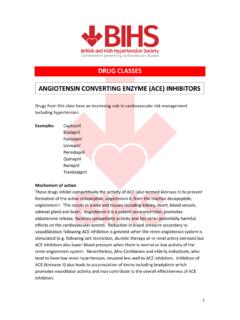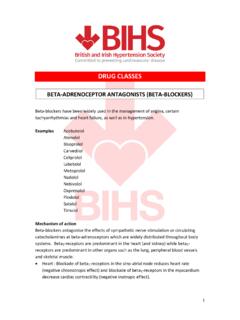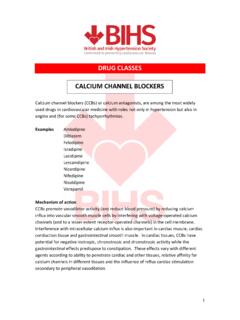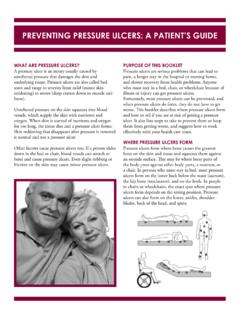Transcription of Home Blood Pressure Monitoring Protocol
1 This resource is a joint production of the NIHR Collaboration for Leadership in Applied Health Research and Care (CLAHRC) Greater Manchester and the British Hypertension Society home Blood Pressure Monitoring Protocol Introduction home Blood Pressure Monitoring (HBPM) is being increasingly used in many health systems worldwide and is well accepted by patients. A recent survey undertaken in the UK found that around 30% of patients with hypertension monitor their own Blood Pressure at home . In other countries, this figure stands at over 70%.
2 To realise the full value of HBPM, however, it is important that HBPM is carried out in a way that is consistent with the current evidence base and therefore in line with this Protocol . All healthcare professionals ( doctors, nurses, healthcare assistants, pharmacists) using HBPM with their patients should be adequately trained and have their performance reviewed periodically. *Please note that the guidance below frequently makes reference to patients with hypertension. However, there will be a group of patients who do not meet the diagnostic criteria for hypertension, but who have Blood Pressure too high for their clinical condition ( CKD, type 2 diabetes).
3 In such cases, HBPM should be used as per the guidance for patients with confirmed or suspected hypertension. 1. Clinical indications for HBPM HBPM provides a useful addition to clinic Blood Pressure measurement in a number of circumstances, including in the: Diagnosis of hypertension, where ambulatory Blood Pressure Monitoring (ABPM) is not tolerated, including in the detection of: o Possible white coat hypertension ( Blood Pressure in the hypertensive range when taken in a clinical setting, but not when taken at home ) o Possible white coat effect in patients with hypertension (a difference of more than 20/10mmHg between clinic Blood Pressure and average home Blood Pressure , but where home readings are still in the hypertensive range.)
4 Such patients are at risk of receiving more Blood Pressure medication than they need) o Possible masked hypertension ( Blood Pressure in the hypertensive range when taken at home , but not when taken in a clinical setting) o Unusual variability of Blood Pressure . Treatment of hypertension, to: This resource is a joint production of the NIHR Collaboration for Leadership in Applied Health Research and Care (CLAHRC) Greater Manchester and the British Hypertension Society o Inform unclear/equivocal treatment decisions o Determine the efficacy of antihypertensive therapy and supporting appropriate adjustment, particularly in hypertensive patients with white coat effect o Support the appropriate adjustment of drug therapy for patients who have been previously misdiagnosed or over-treated o Promote medication adherence (compliance)
5 And lifestyle changes and to make patients more aware of their condition o Evaluate Blood Pressure control in patients discharged home from hospital with newly commenced or altered antihypertensive therapy o Evaluate drug resistant hypertension o Evaluate symptomatic hypotension. Long term Monitoring of patients on stable treatment for hypertension ( hypertensive patients who have well controlled Blood Pressure ). HBPM performed with most automated devices is contraindicated in patients with pulse irregularities, such as atrial fibrillation (AF) [see manufacturers instructions for further information].
6 Prior to introducing HBPM, therefore, in patients not known to have an irregular pulse, it may be appropriate to check for any pulse irregularities (rate and rhythm). Some HBPM devices will do this automatically. HBPM should not be considered universally contraindicated in some patient groups such as those with motor disabilities or cognitive impairments. These patients may be able to undertake HBPM with additional support, either from a trained healthcare professional or family member. 2. HBPM devices and cuffs Devices used for HBPM should be clinically validated for home use.
7 An up to date list of such devices is available at and Where patients wish to purchase their own device, they should be specifically advised to purchase a monitor from this list. If the patient has already purchased a monitor that is not validated for home use, this should not be used for clinical purposes and the patient should be advised that this is the case. An appropriately sized cuff, containing the correct sized inflatable bladder, must be used (see box below) and upper arm monitors are preferred to wrist or watch devices.
8 All devices, including those that belong to patients and those available to loan to them, should be maintained and calibrated according to manufacturers instructions. Where patients are using their own device for HBPM, it is important to check when the monitor was purchased and/or last calibrated. If outside the recommended timeframe for calibration/recalibration, the This resource is a joint production of the NIHR Collaboration for Leadership in Applied Health Research and Care (CLAHRC) Greater Manchester and the British Hypertension Society monitor should not be used for clinical purposes and it should be recommended that the monitor is recalibrated according to the manufacturer s instructions or replaced.
9 It is also good practice to occasionally check patients monitors against other validated devices. If devices are loaned to patients, from an infection control point of view, it is important to ensure that cuffs and inflatable bladders are cleaned according to the manufacturers instructions and in compliance with local infection control procedures. Box 1. Cuff and Inflatable Bladder Size Cuff Sizes Indication Width (cm)* Length (cm)* BHS Guidelines inflatable bladder width and length (cm)* Arm circumference (cm)* Small Adult/Child 10-12 18-24 12 x 18 <23 Standard Adult 12-13 23-35 12 x 26 <33 Large Adult 12-16 35-40 12 x 40 <50 Adult Thigh Cuff** 20 42 <53 * The range of columns 2 and 3 are derived from recommendations from the British Hypertension Society (BHS), European Hypertension Society (ESH) and the American Heart Association.
10 Columns 4 and 5 are derived only from the BHS guidelines. ** Large inflatable bladders for arm circumferences over 42cm may be required. Manufacturers instructions should be referred to for further information setting up the monitor, troubleshooting, battery replacement, calibration, using memory/storage functions. 3. Using HBPM upper arm devices Prior to starting HBPM, patients should measure their Blood Pressure in both arms to determine which arm should be used for future measurements. The arm that gives the higher systolic reading (the top number) should be used for all future testing.
